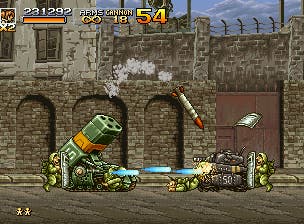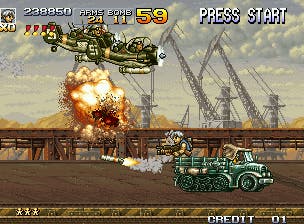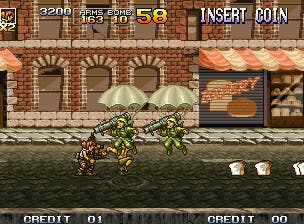Metal Slug 4
Pass the salt, please.
For the first twenty minutes, I loved Metal Slug 4 intensely. It's been long, too long, since I've played a game of such simplicity. There's no cut-scene-based preamble, no mood building: expect exposition no more elaborate than the brief looming of 'boss' before the battle ensues, or a thumbs-up from an ally at the end of a level.
From the moment your character's feet hit the ground in the first stage, Metal Slug 4 is relentless. Enemies attack from left, right and above, you instinctively duck, jump and change your position, and there's a metronomic quality to the hammering of your finger on the fire button.
It's pure, unadulterated, visceral; this is what gaming used to be like before better technology blurred the boundaries between it and cinema.
Bar a few set-piece sequences and minor platforming elements, there's a very simple routine to Metal Slug 4: move from left to right, stop to dispatch a scripted wave of adversaries, catch breath, repeat. Its opening exchanges pit you against cannon-fodder soldiers, but a more involved pattern of play emerges as you progress. One of its (oft-repeated) tricks is to pit you against a relatively strong foe - such as a helicopter, or a tank of some description - and then distract you with the introduction of a wave of easily dispatched grunts. This forces you to strategise, but in an immediate, non-rational kind of way. There's the unthinking comprehension that foot-soldiers are only dangerous if allowed to accumulate in sufficient numbers - or, more pressingly, allowed to linger long enough to take a pot-shot - and so you manage the screen carefully, dividing your time between threats.
The more onscreen enemies there are, the more time you spend dodging projectiles. The weapon collection system in principle places an emphasis on staying alive. If you die, you revert to your default pistol, which is relatively weak, can only be fired at 90-degree angles, and is your least effective means of maintaining crowd control. When you collect a more powerful weapon (of which there are several, with a machine gun and a rocket launcher being staples), your ability to clear the screen is enhanced. It's a success begets success thing: the longer you can stay alive, the more equipped you are to remain so. Die during an extended battle, and there's a good chance that your subsequent life will be fleeting.

With an infinite number of continues to play with, though, you soon realise that what Metal Slug 4 lacks is the ability to evoke any feeling that, personal pride aside, dying actually matters. There are moments where you can climb aboard vehicles - including the titular Metal Slug tank, a Bradley missile launcher, and a forklift truck - and wreak havoc. This is Metal Slug 4 at its best: enormous firepower, explosions everywhere, and the central one-hit-deaths mechanic replaced by a short energy bar. You don't want to relinquish control of these toys cheaply, and so you frantically fire and dodge, utterly immersed in acts of wanton destruction. When they're destroyed, you feel disappointment: this is as close to 'losing' as you get.
Ultimately, there are no real penalties for playing Metal Slug badly: you get as much out of it as you're willing to put in. During its choreographed boss battles, for example, there's a traditional onus on learning attack patterns and reacting accordingly. But as you're playing with infinite lives, with no danger of being returned to the start of a level or a checkpoint, you soon realise that it's not necessary to do so. As your stock of grenades is replenished after each life is lost, you can use the après-death period of invulnerability to throw them all, die, then continue the procedure until you beat your screen-sized foe. Metal Slug 4's difficulty level technically leaps into the stratosphere during later levels - but what's the point of confronting players with one gigantic wall of bitmap-based brutality after another to scale, only to leave an unlocked door at the base of each?

And then suddenly, within an hour, it's over.
Even a modestly gifted player will complete Metal Slug 4 within sixty minutes. Granted, it has a handful of alternative routes through specific areas to try out, and a host of collectables to find if you're the completist type, but you can plough through the main body of it next to no time. The idea, of course, is that you then play through it again, seeking a higher score, to use less continues, to find things that you missed previously. Is it fun to do so? Yes. Is there a sense of reward for doing so? Well...
As a boy, my favourite arcade machines were side-scrolling slash-'em-up Green Beret and beat-'em-up Double Dragon. I was too young for a paper round, so every occasional twenty pence that pester-power could prise had to be put to good use. I mastered the art of finishing both with a single credit (after a certain amount of practice, obviously), and felt like a veritable god of gaming for being able to do so. The sense of accomplishment was immense - and that's exactly what Metal Slug 4 lacks.

As a quick, frantic lo-fi fix, it's lovely (and, moreover, budget-priced). But come on: what would it have taken to introduce checkpoints, or a system whereby players gradually accumulate additional credits through high scores? I want to care whether I live or die, dammit. Metal Slug 4 is intense, immediate and fun in all the right ways, but it's disposable entertainment in every sense of the phrase.
